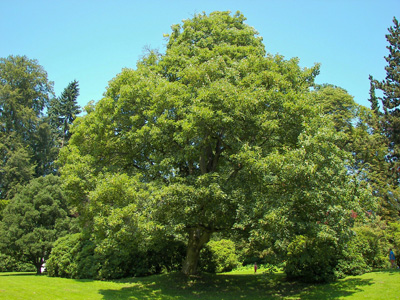- Series:Plants, Transcript English
Luke 19:4
“And he ran before, and climbed up into a sycomore tree to see him: for he was to pass that way.”
 I grew up in a house surrounded by a sycamore wood. Perhaps 50 percent of the trees were sycamores. I loved these fascinating trees. I was taught that Zacchaeus (who was a very little man, according to the children’s song) climbed up into the sycamore tree to see Jesus. This is not strictly correct, as the sycamore mentioned in Luke’s gospel is a type of fig tree and not really related to the sycamore in Britain. Even the British sycamore is not native to Britain, having been introduced from Europe in the 1500s. The famous tree in Tolpuddle, England, where the Trades Union movement was founded in 1834 by the Tolpuddle Martyrs, was a sycamore tree and is, therefore, known as “the Martyr’s Tree”.
I grew up in a house surrounded by a sycamore wood. Perhaps 50 percent of the trees were sycamores. I loved these fascinating trees. I was taught that Zacchaeus (who was a very little man, according to the children’s song) climbed up into the sycamore tree to see Jesus. This is not strictly correct, as the sycamore mentioned in Luke’s gospel is a type of fig tree and not really related to the sycamore in Britain. Even the British sycamore is not native to Britain, having been introduced from Europe in the 1500s. The famous tree in Tolpuddle, England, where the Trades Union movement was founded in 1834 by the Tolpuddle Martyrs, was a sycamore tree and is, therefore, known as “the Martyr’s Tree”.
I always found the way that sycamores reproduced to be fascinating. The fruits consist of a seed, about one quarter inch in diameter, attached to a wing, about one inch long. The fruits are stuck in pairs, so the seed pair also has a pair of wings. When these drop from the tree, they spiral downwards quite slowly and can get caught by the wind and blown quite a distance away from the tree, looking for all the world like tiny helicopters. The distribution of seedlings around the parent sycamore tends to be asymmetric, as there will be more seedlings on the side opposite from the direction of the prevailing wind. This unusual seed scattering points to the great variety with which God has blessed us in His creation.
Prayer: Thank You, Lord, for beautiful, majestic trees that stand so long and so solid and are havens for so much wildlife. Though they are not eternal, they stand so long that they remind us of Your eternity. Amen.
Author: Paul F. Taylor
Ref: < http://www.mikepalmer.co.uk/woodyplantecology/sycamore/britain.htm >, accessed 3/1/2019. Image: Photograph of Sycamore, by “Willow”, CC SA-BY 2.0 Generic.
© 2020 Creation Moments. All rights reserved.
